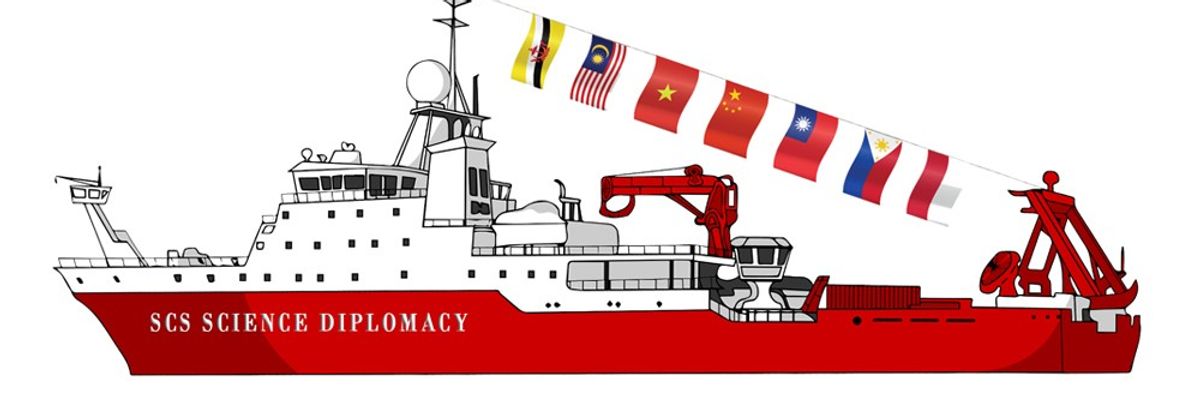The South China Sea is a unique natural laboratory for ocean research and exploration. And yet, this rifted basin, dotted with atolls, coral reefs and islets, is mired in disputed territorial claims between China, Vietnam, Taiwan, the Philippines, Malaysia and Brunei.
It could be a gateway for oceanographic research, peace, and prosperity; instead, rising regional tensions and mistrust pose a grave threat to geopolitical and ecological security in Southeast Asia.
China’s leader Xi Jinping vowed at the Communist Party’s five-year national congress last month to pursue peaceful unification with Taiwan. Meanwhile, a growing number of policy experts and marine scientists believe that a network of marine protected areas, or MPAs, already provide the common ground in both cross — strait relations and in the South China Sea .
Tension between the United States and China is an obstacle to regional cooperation over marine cooperation in the South China Sea. But cooperation can and does address the softer issues, such as fisheries management and marine science research. MPAs offer the potential to build trust among nations, conserve biodiversity and sustain marine life.
More than 625 million people of the 10 Association of Southeast Asian Nations depend on a healthy global ocean. But coral reefs are dying as a result of an ecological catastrophe taking place in the region’s once–fertile fishing grounds. With reclamations destroying marine habitats, agricultural and industrial run-off poisoning coastal waters, and overfishing depleting fish stocks, marine biologists are vital for building a rules-based ecological approach to protect the environment and offset the threats to endangered species.
The China-ASEAN Plan of Action on a Closer Partnership of Science, Technology and Innovation (2021–25), a new mechanism for science–driven cooperation, offers a model. This agreement, along with marine environment–focused forums and workshops, are shaping a new South China Sea narrative about the ecological dangers of biodiversity loss, climate change, coral reef depletion, pollution, and collapsing fisheries.
“As scientists, we should rise above politics and focus on the bigger and more important questions central to humanity’s long-term wellbeing,” said Professor Nianzhi Jiao, an ecologist at Xiamen University, at a South China Sea forum held in Shanghai.
There are historical precedents for international oceanic collaboration. In 2014 scientists from the United States, Japan, China, South Korea, Australia, India and Brazil conducted tectonics drilling surveys in the South China Sea under the auspices of the International Ocean Discovery Program (IODP). The South China Sea Monsoon Experiment (1996–2001), initiated by China’s Ministry of Science and Technology, brought together scientists from Taiwan, Australia and the United States.
The collaboration chronicle includes the Joint Oceanographic Marine Scientific Research Expeditions conducted between the Philippines and Vietnam in the South China Sea (JOMSRE-SCS) from 1996–2007. The Philippines and Vietnam agreed last year to resume their joint marine scientific expedition, but COVID–19 delayed their mission.
Despite a history of conflict between China and Vietnam the two nations continue to observe the Gulf of Tonkin agreement, ratified in 2004, which ensures cooperation in fishing, hydrocarbon exploration and maritime security. Now their marine scientists and policy experts, increasingly worried about the environmental degradation in the South China Sea, are conducting workshops that offer a promising outlook for expanded marine protected areas that would bolster environmental security and use shared resources more equitably.
Dr. Weidong Yu, a senior researcher at the School of Atmospheric Sciences at Sun Yat-Sen University, says that “ocean science cooperation is the best way forward” to deal with climate change, extreme weather and marine ecosystems.
Since scientific evidence informs negotiations, fosters joint marine research and capacity building, ocean science is a diplomatic tool for peace building.
Science in diplomacy has been adopted by the Arctic Council, a leading intergovernmental forum, established in 1996. Composed of eight Arctic nations — including the United StatesRussia, and indigenous groups — it is a stellar example of science and technology-based collaborative research. The Council members have enacted several legally binding agreements that reinforce environmental protection and sustainability.
Dr. Paul Berkman, past director of the Science Diplomacy Center at Tufts and Fulbright Arctic Chair, said that the Arctic Science Agreement, signed in 2017, “reflects a common interest to enhance scientific cooperation even when diplomatic channels among nations are unstable.
While some policy experts believe that China’s embrace of science cooperation offers evolving evidence of what Beijing characterizes as their “peaceful rise,” others view the nation’s blue water ambitions and regional hegemonic actions in the South China Sea as a clear threat to every state in the region.
In the interim, claimant nations understand the urgency of creating mechanisms for ocean governance to prevent geopolitical battles over marine resources in the ‘Global Commons’. Given that this is an area where science and geopolitics converge, the path to agreement involves expanding scientific forums and collaborative problem solving — i.e., science diplomacy.
The consensus among environmental policy planners is that science diplomacy contributes significantly to conflict resolution.
One area of scientific consensus is in the expansion of marine protected areas to mitigate the collapse of fisheries in the region. Destructive fishing practices and climate change are major threats to coral reefs. China has more than 270 marine protected areas and its neighbor Vietnam has 12 under protection.
John McManus, a distinguished University of Miami biology professor and ecologist, has been promoting marine protected areas for over two decades. Together with Dr. Kwang-Tsou Shao and Dr. Szu-Yin Lin of Taiwan’s Biodiversity Research Center he co-authored a paper advocating the establishment of an international peace park in the South China Sea to better manage marine resources and reduce regional tensions.
This proposal bolsters a revived China–ASEAN Cooperation Framework, especially in workshops on marine environmental protection. With the largest fleet of marine research vessels deployed in the Indo-Pacific, China can help support fisheries for the benefit of all states with data sharing and by mapping ecologically sensitive areas.
Geopolitics is always at play in the contested South China Sea. While the Biden administration said that managing the Sino-American relationship is “the biggest geopolitical test of the 21st century,” Woods Hole Oceanographic Institute (WHOI) and the Ocean University of China (OUC) have been engaged in promoting research collaborations in deep-ocean and coastal regions in a changing climate.
Cooperative science activities do not have any effect on the status quo of the South China Sea disputes. But it does maintain hope for a solution to these disputes with confidence-building activities that keep all the parties engaged. The alternative is political deadlock.
For now, at least, scientific research can rise above the geopolitical noise of sovereignty claims.
















